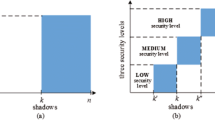Abstract
Secret image sharing has been researched intensively, and it has emerged as an alternative to data hiding for protecting the security and privacy of important data. In the traditional (t, n) threshold secret image sharing schemes, any t or more shadow images can reconstruct the shared secret image. However, in real applications, (t, n) threshold access structures cannot meet all of the requirements, such as the adversary structure, which means that unauthorized groups of participants cannot reconstruct the shared secret. Thus, in (t, n) threshold secret sharing with adversary structure, t participants who want to reconstruct the secret cannot do so if they happen to belong to the defined adversary structure. This novel characteristic has the potential to work in many applications. However, the existing secret image sharing mechanisms cannot achieve the adversary structure. To solve this problem, we proposed a secret image sharing scheme that can achieve the adversary structure. In addition, our scheme also is a (t, n) threshold secret image sharing scheme. That is, t or more shadow images can be used to reconstruct the secret image, but some subsets that contain at least t shadow images among the adversary structures cannot reconstruct the secret image. The experimental results showed that the validity of our scheme is satisfactory.





Similar content being viewed by others
References
Benaloh J, Leichter J (1989) Generalized secret sharing and monotone functions, Proc. Crypto’88, Lecture Notes in Computer Science. Springer, Berlin, pp 213–222
Blakley GR (1979) Safeguarding cryptographic keys. Proc AFIPS Natl Comput Conf 48:313–317
Chang CC, Lee HC (1993) New generalized group-oriented cryptoscheme without trusted centers. J IEEE J Sel Areas Commun 11(5):725–729
Guo C, Chang CC, Qin C (2012) A hierarchical threshold secret image sharing scheme. J Pattern Recognit Lett 33(1):83–91
Guo C, Chang CC, Qin C (2012) A multi-threshold secret image sharing scheme based on MSP. J Pattern Recognit Lett 33(12):1594–1600
Guo C, Chang CC, Qin C (2014) A novel (n, t, n) secret image sharing scheme without a trusted third party. Multimed Tools Appl 72(3):2195–2209
Guo C, Zhang H, Song QQ, Li MC (2015) A multi-threshold secret image sharing scheme based on the generalized Chinese remainder theorem. Multimed Tools Appl. doi:10.1007/s11042-015-2885-x, Online 20 August 2015
Ito M, Saito A, Nishizeki T, (1987) Secret sharing schemes realizing general access structure. Proc. IEEE Global Telecommunication Conference, IEEE Press, New Jersey, pp. 99–102
Li J, Li XL, Yang B et al (2015) Segmentation-based image copy-move forgery detection scheme. IEEE Trans Inf Forensic Secur 10(3):507–518
Lin PY, Chan CS (2010) Invertible secret image sharing with steganography. J Pattern Recognit Lett 31(13):1887–1893
Lin PY, Lee JS, Chang CC (2009) Distortion-free secret image sharing mechanism using modulus operator. J Pattern Recognit 42(5):886–895
Lin CC, Tsai WH (2004) Secret image sharing with steganography and authentication. J Syst Softw 73(03):405–414
Lin YY, Wang RZ (2010) Scalable secret image sharing with smaller shadow images. J IEEE Signal Process Lett 17(3):316–319
Ma J, Guo Y (2004) Practical secret sharing scheme realizing generalized adversary structure. J Comput Sci Technol 19(4):564–569
Ma TH, Zhou JJ, Tang ML et al (2015) Social network and tag sources based augmenting collaborative recommender system. IEICE Trans Inf Syst E98-D(4):902–910
Naor M, Shamir A (1995) Visual cryptography. Advances in cryptology, Proc. Eurocrypt’94. Spring-Verlag, Berlin, pp 1–12
Pang L, Jiang Z, Yumin AW (2006) Multi-secret sharing scheme based on the general access structure. J Comput Res Dev 43(1):33–38
Qin H, Dai Y, Wang Z (2009) A secret sharing scheme based on (t, n) threshold and adversary structure. J Int J Inf Secur 8(5):379–385
Ren YJ, Shen J, Wang J et al (2015) Mutual verifiable provable data auditing in public cloud storage. J Internet Technol 16(2):317–323
Shamir A (1979) How to share a secret. Commun ACM 22(11):612–613
Shyu SJ, Chen YR (2008) On secret multiple image sharing,” proc. The 25th workshop on combinatorial mathematics and computation theory. Chung-Hwa University, Hsinchu, pp 24–25
Tan KJ, Zhu HW (1999) General secret sharing scheme. J Comput Commun 22(8):755–757
Thien CC, Lin JC (2003) An image-sharing method with user-friendly shadow images. J IEEE Trans Circ Syst Video Technol 13(12):1161–1169
Wang RZ, Su CH (2006) Secret image sharing with smaller shadow images. J Pattern Recog Lett 27(6):551–555
Xia ZH, Wang XH, Sun XM et al (2015) A secure and dynamic multi-keyword ranked search scheme over encrypted cloud data. IEEE Trans Parallel Distrib Syst 27(2):340–352
Xia Z, Wang X, Sun X, Xiong N (2014) Steganalysis of least significant bit matching using multi-order differences. J Secur Commun Netw 7(8):1283–1291
Xia Z, Wang X, Sun X, Xiong N (2016) Steganalysis of LSB matching using differences between nonadjacent pixels. J Multimed Tools Appl 75(4):1–16
Yang CN (2004) New visual secret sharing schemes using probabilistic method. J Pattern Recog Lett 25(4):481–494
Yang CN, Chen TS, Yu KH, Wang CC (2007) Improvements of image sharing with steganography and authentication. J Syst Softw 80(7):1070–1076
Zhao D, Peng H, Wang C, Yang Y (2012) A secret sharing scheme with a short share realizing the (t, n) threshold and the adversary structure. J Comput Math Appl 64(4):611–615
Acknowledgments
This paper is supported by the National Science Foundation of China under grant No. 61401060, 61501080 and 61572095, the general program of Liaoning Provincial Department of Education Science Research under grants L2014017, and the Fundamental Research Funds for the Central Universities’ under No. DUT16QY09.
Author information
Authors and Affiliations
Corresponding author
Rights and permissions
About this article
Cite this article
Guo, C., Yuan, Q., Lu, K. et al. (t, n) Threshold secret image sharing scheme with adversary structure. Multimed Tools Appl 76, 21193–21210 (2017). https://doi.org/10.1007/s11042-016-4065-z
Received:
Revised:
Accepted:
Published:
Issue Date:
DOI: https://doi.org/10.1007/s11042-016-4065-z




